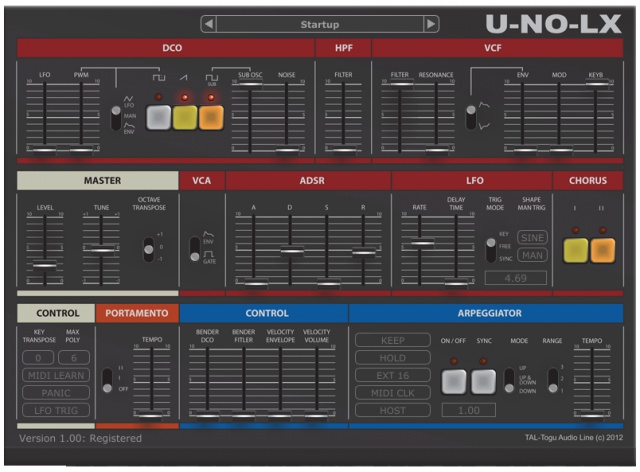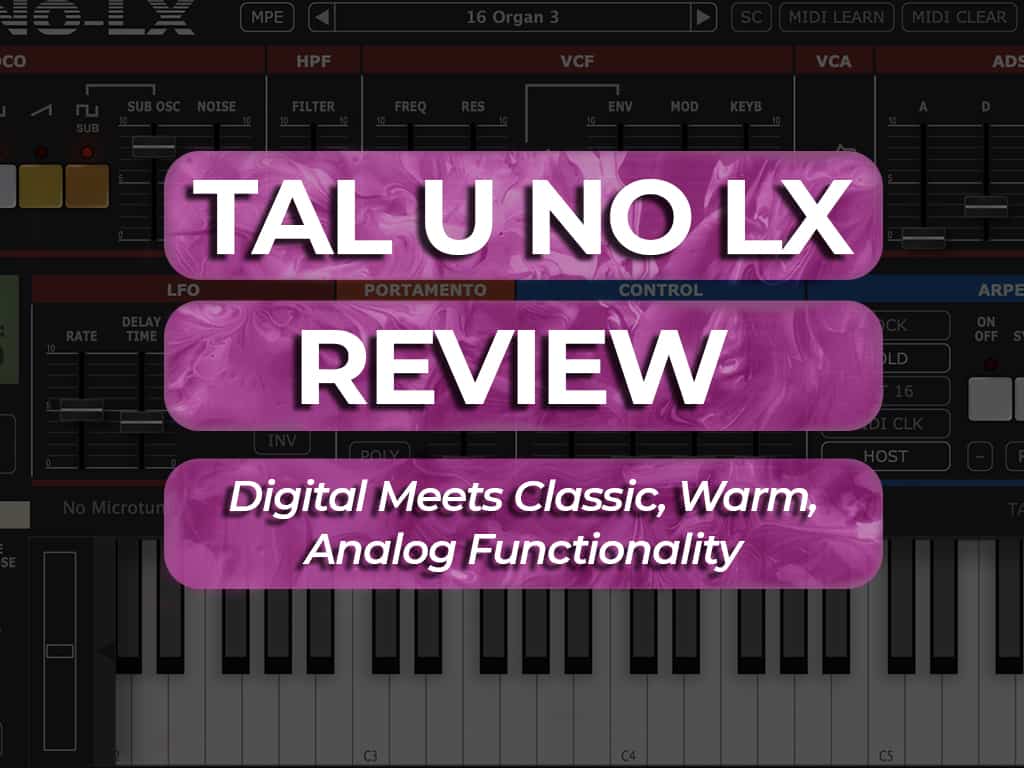The TAL-U-NO-LX is a Virtual Analog software synthesizer plugin that supports all sample rates. The synth was designed to emulate analog hardware as accurate as possible and brings the synth sound of the 80’s back into your DAW. This synth does not use any samples. It’s tested and works within the most common audio hosts as Ableton Live. In this video, we'll take a look at a modern plugin-based take on the classic Juno 60 - the TAL-U-No-LX - a Juno VST.The TAL U NO LX is a completely rewritte. The TAL U-NO-LX is an unapologetically good emulation of the 80’s hardware synth beast – the Roland Juno 60. It’s one of 2 Juno emulations in their line of plugins & is the upgraded, paid version of their free TAL-U-NO-62. TAL prides themselves on creating truly authentic emulations of old hardware gear, & in the U-NO-LX this is no different.
The TAL-U-No-LX is a software emulation of Roland’s popular Juno-60 hardware synth. In contrast to the hardware unit it further comes with some extra features, including portamento, additional filter LFO waveforms, and more. As I’m writing this review the plugin can be purchased for $59.49 via pluginboutique.com*. It’s available for Windows, macOS & Linux.

Also read: The Best Vaporwave Sample Packs 2021
Developer TAL Software enters the iOS market with the release of their Roland Juno app, TAL-U-NO-LX! TAL are extremely popular in the desktop world because they give away a bunch of free plugins, in addition to their paid offerings. The iOS version of TAL-U-NO-LX is $12, $60 on desktop, and arrives with AUv3 and MPE. Presets for the desktop version, including a multitude of third-party presets.
My First Impression
My first impression of the TAL-U-No-LX was quite good. Everything looks clean and is labeled properly, so I downloaded the demo version and opened it up inside Ableton Live. I played around with it for a while and noticed that you can reset all parameters by double-click and the GUI can be resized seamlessly. All knobs work fine and if you have a basic understanding of synthesis it’s quite intuitive to use. Time to dive in a bit deeper..
The Plugin in Detail
The U-No-LX can basically be divided into 4 main sections. At the top you’ll find the presets menu. Below is the main section with all the oscillators, filters, ADSR and the infamous chorus. Next up you’ll find controls for LFOs, portamento & an arp. The last part is the keyboard, which is located at the bottom.
Preset Menu

The preset menu is straightforward and intuitive to use. The demo version (and I guess also the paid one) comes with 4 banks, which are all filled with plenty of arps, basses, leads and everything else you could possibly need. You’ll also get the common options to save & load presets, to show the presets folder and some additional stuff.
Tal U No Lx Logic Pro X
The Main Section

If you haven’t used an “analog” synth yet, the U-No-LX might look a bit complicated to you at first, because you won’t find terms like “oscillator” or “filter” anywhere. The oscillator section for example is labeled with “DCO”. However, once you played around with everything for a while (assumed you have a basic sound design understanding) you should figure out where everything is located.
The synth comes with 3 oscillators, including a square, a saw and a sub, plus extra noise. You can change the pulse’s width + modulate it using the LFO or envelope. The entire synth’s pitch can also be modulated using the LFO. Next up there is a simple high-pass filter and a low-pass filter, you can modulate using envelope, LFO and key.
Tal U No Lx Sweeping

Certainly there’s also an ADSR section, which can be bypassed and on the right side you’ll find the chorus, which comes with 2 algorithms you can use at the same time. This section alone should be enough to create most of the basic “analog” sounds you can hear in so many tracks.
Modulation, Additional Settings & Arp
Although the synth is already quite powerful by now, the guys from TAL made sure to add a bunch of additional features to it, starting with a huge display at the left side, a drop-down menu to transpose the entire synth’s key and a panic knob, which stops the output signal immediately. You can further fine-tune the LFO, make use of portamento and control the pitch wheel’s and velocity’s effects on the sound. At the right side you’ll find an arpeggiator, which comes with a useful hold function, 3 different modes and a range of up to 3 octaves. Like with most arps, the tempo can be set in Hz or synced with your host.
Keyboard
The last section includes the keys, pitch wheel, a knob to transpose the octave up or down, a global volume fader and last, but not least a fader to control the overall master tune.
So how does it sound?
Since the TAL-U-No-LX doesn’t come with any effects built in, that could potentially muddy up the sound (except the chorus), most of the patches sound really clean. The plugin comes with everything you need to create the classic hardware synth sounds we know from the past, so if you’re into Synthwave, Vaporwave or modern pop music you should definitely consider giving it a try. In addition to the warm sound, it’s a great tool to learn analog synthesis and even if you don’t want to make your own sounds it already comes with a big selection of presets. Since TAL is offering a free demo version on their website you can check out the synth by yourself and form your own opinion as well 🙂
Developer TAL Software enters the iOS market with the release of their Roland Juno app, TAL-U-NO-LX! TAL are extremely popular in the desktop world because they give away a bunch of free plugins, in addition to their paid offerings. The iOS version of TAL-U-NO-LX is $12, $60 on desktop, and arrives with AUv3 and MPE. Presets for the desktop version, including a multitude of third-party presets, are compatible with the iOS version!
TAL-U-NO-LX
All sounds are generated in real time without any samples. It produces the raw sound of the original hardware device without any additional effects.
As an addition the software version supports normal MIDI and the newer MPE standard.
All synth parameters support MIDI learn and can be controlled with a hardware MIDI controller. The presets are compatible with the desktop version and a lot of preset banks by third party companies are available for this syntheziser.
Starting the standalone version automatically copies the presets from the document folder into the shared sandbox folder.
Doug Woods did a The Sound Test Room Live Stream for TAL-U-NO-LX, and SoundForMore has started a tutorial series. I've embedded the playlist for it, but right now there are only 2 videos.